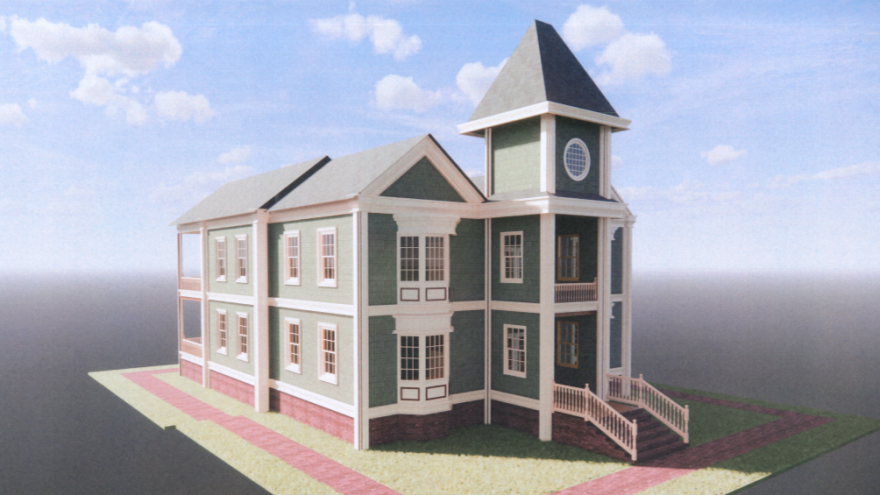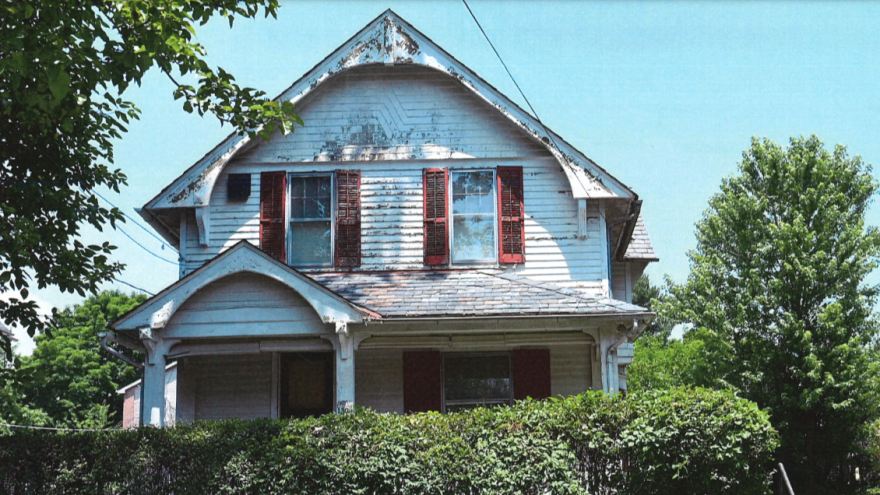BETHLEHEM, Pa. — The Queen Anne-style home at 1304 Spring St. is mold-ridden, has ceilings falling in, needs a paint job and some of its windows won’t even open.
But it’s an indispensable piece of West Bethlehem history and a landmark for the surrounding Mount Airy Historic District, locals argued Monday before the city’s Historic Conservation Commission.
The 2 1/2-story home, which dates to about 1885, hasn’t seen a resident in 15 years.
But it once was home to Bethlehem Steel President Eugene Grace’s head gardener, who lived on the south end of his boss' estate.
And getting it up to snuff for city inspections would be a tall order and not worth the money over other options for the now-occupied land, according to an architect working with the property owner: the Diocese of Allentown.
The Queen Anne-style home at 1304 Spring St. dating to around 1885 hasn’t seen a resident in 15 years. But it was once home to Bethlehem Steel baron Eugene Grace’s head gardener.
Fixing up the home to meet city code would run about $300,000, while just tearing it down would cost about $35,000.
So the diocese — which also operates Holy Family Senior Living close by — has plans to demolish the structure and put up a four-unit, 4,100-square-foot apartment complex for seniors.
That project would cost about $2 million.
For now, the fate of the historic home will be settled at another time while the developer explores further options, following a unanimous vote from the HCC panel to table the proposal.
The group meets at 6 p.m. every third Wednesday of the month in Bethlehem City Hall Rotunda, 10 E. Church St.
A contributing structure
HCC Historic Officer Jeff Long said the part of the city’s ordinance defining contributing structures within the Mount Airy Historic District describes such buildings as built between 1880-1950, a period when that part of West Bethlehem experienced “dramatic development.”
“It doesn't matter if it was built by a famous architect, if someone famous lived there, if it was someone wealthy, if it was someone who was a laborer. Anything built during that time frame, according to the ordinance, is considered contributing to that district.”Bethlehem Historic Conservation Commission Historic Officer Jeff Long
“It doesn't matter if it was built by a famous architect, if someone famous lived there, if it was someone wealthy, if it was someone who was a laborer," Long said.
"Anything built during that time frame, according to the ordinance, is considered contributing to that district.”
By that same token, the HCC’s purview doesn’t specifically deal in the humanity of historic structures but rather how they fit within and benefit the surrounding neighborhood.
The panel of volunteers is a recommending body, sending its yea or nay to City Council for further review. Only if city officials sign off on the proposal does the applicant get a permit for their respective project.

A 'significant' loss on the line
Based on his walk-by inspection, Long said the home holds a high level of historic integrity among similar structures nearby, and “its loss to demolition would be significant to the existing streetscape and also to the overall district.”
A case of undue economic hardship on the applicant and an exhaustion of all other attempts to reuse the building are key in potentially approving such a razing.
Salvatore Verrastro, president of Spillman Farmer Architects, who spoke on behalf of the applicant, said making appropriate repairs to maintain the historical authenticity of the property wouldn't mean the home would pass inspections.
“The costs to repair the building are astronomical and far exceeds the cost of the existing structure as it is,” Verrastro said.
“But even putting it back and repairing it to its existing condition … it’s probably not something that would be usable for Holy Family because the rooms are so small; the bathrooms, they’re antiquated to say the least.”
“The costs to repair the building are astronomical and far exceeds the cost of the existing structure as it is."Salvatore Verrastro, president of Spillman Farmer Architects, who spoke on behalf of the applicant
Verrastro said the current building had “zero significance” in the neighborhood, and its proposed replacement would better fit the surroundings.
The home was even appraised at $0 because “it’s [in] that bad of shape,” Verrastro said.
Panel member Todd Chambers wondered why the diocese would dump the proposed amount of money into building the new apartments when it could maybe both keep the home standing and have some apartments elsewhere on the lot.
“You could preserve this building, preserve this streetscape and then potentially build the additional units as an addition and behind it, around it,” Chambers said.
'A horrible precedent'
Mary Toulouse, president of the Mount Airy Neighborhood Association, said approving the demolition of the Spring Street home would be a “tragic loss” considering the historical prominence of the area.
Eugene Grace, who served as Steel president from 1916-45, lived in a mansion on Bonus Hill at nearby 1317 Prospect Ave. from 1923 to 1960.
“I think that this would be a horrible precedent for the rest of the Historic District, that includes another property that has been neglected by the Diocese and puts that one in danger as well."Mary Toulouse, president of the Mount Airy Neighborhood Association, speaking on the potential demolition of “the gardener’s house”
The Diocese of Allentown bought that home in 1962 and used it as a senior care facility before expanding operations on surrounding land and in other municipalities in the decades following.
“I think that this would be a horrible precedent for the rest of the Historic District, that includes another property that has been neglected by the diocese and puts that one in danger as well,” Toulouse said of the potential demolition of “the gardener’s house.”
A look back and forward
City resident Pat Deluva took a moment at the mic to reminisce, speaking of the estate’s once “fabulous greenhouses,” koi ponds and gardens full of flowers and vegetables.
She said her grandfather lived there and worked for Grace from 1933-61.
“I drive by [the home] frequently, and it breaks my heart, quite frankly, to see this home literally falling apart,” Deluva said.
“I have not seen any evidence that anything really has been done to preserve it.”
“I drive by [the home] frequently, and it breaks my heart, quite frankly, to see this home literally falling apart. I have not seen any evidence that anything really has been done to preserve it.”Bethlehem resident Pat Deluva, who said her grandfather was Eugene Grace's head gardener
City resident Bill Pottinger said that while preserving the home is important, providing the elderly with somewhere to live should take priority.
A neighbor to the north, Kenneth Loush, said Holy Family should take note to not let such disrepair of a building happen again on its property, and the city should stay on top of landowners when structures begin wearing away.
Ultimately, Loush said losing the home would be “detrimental.”
“We’re not really just talking about wood and nails and slate roofs,” Loush said.
“We’re talking about parts of the city here that tell the story.”


